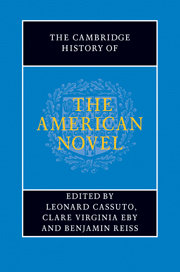Book contents
- Frontmatter
- General Introduction
- PART ONE INVENTING THE AMERICAN NOVEL
- PART TWO REALISM, PROTEST, ACCOMMODATION
- PART THREE MODERNISM AND BEYOND
- PART FOUR CONTEMPORARY FORMATIONS
- Introduction: contemporary formations
- 58 Postmodern novels
- 59 The nonfiction novel
- 60 Disability and the American novel
- 61 Model minorities and the minority model – the neoliberal novel
- 62 The American borderlands novel
- 63 The rise of the Asian American novel
- 64 Toni Morrison and the post-civil rights African American novel
- 65 Hemispheric American novels
- 66 The worlding of the American novel
- 67 The Native American Tradition
- 68 Contemporary ecofiction
- 69 Graphic novels
- 70 Twentieth- and twenty-first-century literary communities
- 71 A history of the future of narrative
- A selected bibliography
- Index
70 - Twentieth- and twenty-first-century literary communities
from PART FOUR - CONTEMPORARY FORMATIONS
Published online by Cambridge University Press: 28 July 2011
- Frontmatter
- General Introduction
- PART ONE INVENTING THE AMERICAN NOVEL
- PART TWO REALISM, PROTEST, ACCOMMODATION
- PART THREE MODERNISM AND BEYOND
- PART FOUR CONTEMPORARY FORMATIONS
- Introduction: contemporary formations
- 58 Postmodern novels
- 59 The nonfiction novel
- 60 Disability and the American novel
- 61 Model minorities and the minority model – the neoliberal novel
- 62 The American borderlands novel
- 63 The rise of the Asian American novel
- 64 Toni Morrison and the post-civil rights African American novel
- 65 Hemispheric American novels
- 66 The worlding of the American novel
- 67 The Native American Tradition
- 68 Contemporary ecofiction
- 69 Graphic novels
- 70 Twentieth- and twenty-first-century literary communities
- 71 A history of the future of narrative
- A selected bibliography
- Index
Summary
The Great Books Foundation, The Big Read, Oprah, and online literary communities, such as those found on LibraryThing.com, are a few contemporary formations of literary communities – or sites of shared reading – that are the descendants of those identified by Barbara Hochman in chapter 36 in this collection. Twentieth- and twenty-first-century readers were and are still influenced by “cultural insiders (authors and literary commentators; educators and newly professionalized librarians),” but social advances along with technological advances, such as radio, television, and the internet have had an impact on the practices and perceptions of shared reading, as well as the book choices readers make.
As Hochman argues, fiction-reading maintained its position as a contested social practice well into the twentieth century. She illustrates well fiction's contested terrain within late nineteenth-century social groups; this chapter picks up the story to identify some of the contemporary debates around reading literature, and in particular, what constitutes “good” literature. To do this, I focus on groups of readers, which are, of course, comprised of individual readers. Literary communities position reading not only as an individual activity but also as a social one, and they provide the analyst with opportunities to evaluate how literary taste and taste hierarchies are influenced by social structures. By attending to the ideological and political basis of groups of readers, we may set the text aside as an object of analysis and instead emphasize the social structures that revolve around readers and their reading choices.
- Type
- Chapter
- Information
- The Cambridge History of the American Novel , pp. 1154 - 1167Publisher: Cambridge University PressPrint publication year: 2011



